The perfect beach smell
 The inner intellectual abhors the manipulated image of beach babes that are flooding today’s media. Fake breasts, dyed highlighted hair, gleaming teeth, self-tanned skin, smiles up to the ears for no apparent reason, gams that go on for miles. Not all of that is bad, really, and I insist on that point vehemently (I could do with the gams fine myself) but perhaps when the total equals Jessica Simpson (it's her birthday today, by the way) as Daisy in the remake of that formative kitsch TV series of the same name Dukes of Hazard, maybe one has second thoughts.
The inner intellectual abhors the manipulated image of beach babes that are flooding today’s media. Fake breasts, dyed highlighted hair, gleaming teeth, self-tanned skin, smiles up to the ears for no apparent reason, gams that go on for miles. Not all of that is bad, really, and I insist on that point vehemently (I could do with the gams fine myself) but perhaps when the total equals Jessica Simpson (it's her birthday today, by the way) as Daisy in the remake of that formative kitsch TV series of the same name Dukes of Hazard, maybe one has second thoughts.
The inner perfumeholic though seeks the bewitching beachy smell that usually accompanies all that nude flesh exposure to the sun and paparazzi cameras, especially at this time of the year.
That smell is centered on an ingredient called monoi, a mix of tiare flower (a kind of gardenia, although it means flower in general in those exotic places) and vegetal oil, traditionally coconut.
Why we have connected the two in our unconscious, since beach smells originally were evocative of Tahiti, Fiji and other Polynesian insular beauties, is a mystery of modern pop culture, a subject that fascinates me personally by its sheer inexplicability.
Enter the futile hunt for the perfect beach smell, the perfect exotic monoi that will transform us in our minds into the voluptuary intellectual: a contradiction in terms, perhaps. But one isn’t bounded by either Epicureans or Stoics. One can combine elements in this multicultural, confusing world.
Several perfumes, mostly perfume oils though, have tried and some have come close: Monyette Paris is so much preferred by the Hollywood celebutantes that one might be excused for thinking they must get plastered with some by their agents as soon as they sign for a major part. The nag champa note in there has the ability to make it smoky though and combined with the very sweet aspect of the overall composition it becomes quite suffocating to me. Kai perfume oil is truer, greener gardenia and very nice at that, but the price for such a small roll-on must be one of the reasons behind capitalism’s success in today’s world - besides the antagonism of men while scoring female conquests, that is….
Bobbi Brown Beach is another effort to capture that elusive smell and the packaging alone makes me salivate as if I am indeed drinking a Caipirinha dancing the salsa along an endless beach. I quite liked the exotic, complex aspect of Songes by Annick Goutal, a fragrance whose floriental character reminds me personally of monoi quite a bit in the initial stages.
The nicest rendition of straight monoi however has got to be this summer’s new addition in a range that is famous for its sun products, Dior Bronze .
Dior, that bastion of makeup and skjncare, if not perfumes any longer (I will probably never forgive them the tampering with Dioressence and the launch of Miss Dior Cherie under that particular name) has a line that contains some of the best self-tanners on the market and some equally delightful sunscreens as well.
What does that have to do with perfume, you might ask?
Granted, we are not going to talk about an eau de toilette or eau de parfum, although Dior has issued a beachy smelling one called Sweet Sun. However, that one is not as nice as the new offering, because it has a discordant conjunction of citrus and powder like baby talc that “drowns” the floral in my opinion.
The new product I came across is called Monoi Gelée Moisturizer.
Yes, I’m afraid my fix comes from a cream. Which might have connotations. Or not.
The fact is it’s a delicious smooth smell of light gardenia scent mixed with tropical coconut that does not come off as plastic, like the shredded variety that comes in a box or tin and which would embarrass even immigrants’ from poor countries kitchens with its foul rubbery odor. There is the lightest underscoring of vanilla and thus it never becomes oversweet. It blends in with the natural scent of the skin and smells sensuous and captivating. Only drawback is that it isn’t strong enough to smell across the room if that’s what you’re going for or to last long if you apply too lightly.
The formula is ethereal and non greasy, being halfway between a cream and a gel and whatever shimmer is in the product it is so miniscule that no one would ever notice it even if you pointed it out to them. It melts on the skin imparting a luminous glow that would be so in touch with your inner Haitian.
And the best part: it can be used not only on skin, but also on hair, thanks to its light greaseless texture, which completes the Gauguin-esque portrayal for you.
Take care not to seduce any hermit painters who have left family behind into abandoning them completely.
What is your perfect beach scent? I'd love to hear about it.
Artwork: Joyousness by Paul Gaugin (courtesy of edu.uni-klu.ac.at)
three comments
Oh how I begin to hate you! Kidding, but you make me crave that which I cannot afford, sigh. Ah, monoi – how do I love thee let me count the ways…
I’ve been thinking of getting BB Beach oil, and what brand is this amazing cream you mention? I’d love to track it down!
Snarkattack - 19 08 06
G,
I am awaiting your impressions on BB Beach. The cream I mentioned is actually the subject of the post, so sorry for the confusion. The whole name is Dior Bronze Monoi Gelee Moisturiser. It’s between a gel and a cream, very nice and retails around 23 euros. I hope it’s clear now.
perfumeshrine - 22 08 06
Thanks for clarifying. That Dior gelee stuff sounds nice! I wasn’t intending to, but when I heard that the BB oil is quite nice, I bought one on eBay, only because it was selling way under retail.
Snarkattack - 23 08 06
A fairy named Nina
 I have often wondered if appearances correspond to the reality or essence of a personality and vice versa, as I am sure you have too. The duality of a person is always fascinating to unravel. And an inconsistency often contributes to a greater fascination. Whether one will tolerate one in favor of another is entirely a personal matter.
I have often wondered if appearances correspond to the reality or essence of a personality and vice versa, as I am sure you have too. The duality of a person is always fascinating to unravel. And an inconsistency often contributes to a greater fascination. Whether one will tolerate one in favor of another is entirely a personal matter.
Nina, the new perfume by Nina Ricci is such a case.
Created as a perfume to evoke in ladies' minds a modern fairy tale for “all young women searching for surprise and fantasy… in a wonderland where dreams dress reality”, as the advertising tells us, it promises to be magical and enchanting. Full of charm and seductiveness.
Fairy tales are the escapism valves of modern hectic lifestyles and if one is so easily within one's grasp it seems like a much healthier idea than downing a couple of pills, don't you agree?
The store in which I went in search for it had an entire window devoted to the new launch: a huge silver tree was posing, with factice bottles resembling glorious red apples hanging from its branches like magical instruments of witchcraft and pieces of ivory organza interlaid on a silvery snowy ground in the middle of summer.
It was beautiful….
The bottle, designed by French agency LOVE, is indeed one of the most gorgeous of recent years, paying homage to Hypnotic Poison, Lolita Lempicka and Be delicious, but managing to be more friendly that any of those and less heavy than the former two. It is also reminiscent of another great bottle that has launched very recently, Delices de Cartier.Made of transparent glass and silver metal it becomes raspberry red by the inclusion of the bright-hued juice. On the top, silver leaves crown an ergonomic sprayer that sprays a fine mist.
The fragrance itself is touted as the brand's single most important release in 10 years, after several trials that didn’t take off as expected. Premier Jour and its variations – let’s face it- never took off (the same goes for Les Belles, 3 variations in similar bottles) although it’s a likeable perfume and the name of Nina Ricci has remained in its dove garlanded laurels for too long.
Nina was composed by noses Olivier Cresp (the nose behind Angel, revamped Femme and Noa) and Jacques Cavallier (of Eau d’Issey, Feu d’Issey, Ferragamo woman and Poeme fame) of Firmenich with the Asian consumer in mind. I am not sure if by Asian they mean Chinese, Japanese, Thai people etc or they mean Middle-east and India, but the perfume could accommodate both tastes being tied with neither tradition or culture.
The brand is simply hoping to strengthen their appeal in the international fragrance market and in particular in Asia, which is the sleeping giant of consumerism, it seems.
Nina has a rich tradition to follow: Nina Ricci was one of the most popular couturiers in the mid-20th century fashion scene. Born in Turin in January 1883 she started as a highly talented apprentice, before devoting herself entirely to design.
She formed a partnership with her only son Robert in order to open her own Haute Couture house at 20, Rue des Capucines, in Paris. Her effort paid off well in quick success and just before the war the NINA RICCI firm occupied 11 floors and its workshops were filled with 450 workers.
Madame Ricci had a flair for highlighting the personality of her clients, resulting in very becoming dresses. She always favoured femininity over trends and elegance over dare. Ricci tried her hand in perfume making with the iconic spicy floral L’air du temps, a fantasia of delicate undertones and tender warmth encased in the gorgeous Lalique bottle with the pair of doves on the stopper, that has been worn by our dearest and nearest for years. It managed to inspire numerous mysterious florals, Fijdi and Anais Anais being two of those and it became a bestseller in many countries, managing to sell one bottle every 3 minutes somewhere around the world.
Alas, it has been so tampered with in its present version, as to render whiffs of it unrecognisable to the olfactory memory of our minds, failing to bring back the images of those loving female figures in our lives. A pity…
Farouche and Coeur Joie are another two legendary Nina Ricci perfumes that remain in the confines of the vast vault of on-line auction shopping.
Robert Ricci , however, Nina’s son, created the original NINA perfume, a powdery floral with fruits and woodsy, green notes in homage to his late mother in 1987. Very recent in perfume terms.
The experiment was very successful artistically, however the business end was not met satisfactorily, resulting in a semi-retirement of the old version, which is not so readily available anymore. Whether it will be retired for good in prospect of substituting it with the new namesake remains to be seen, although the lovely girls who helped me had both versions in the store.
The new Nina bears no resemblance to the older one, but the identical name will surely cause trouble to the consumer and confuse those who like to order things by the phone or on-line.
Whereas the old version was an affair of traditional elegance with a rich sparkle of aldehydes in the opening and a green chypre accord that was quite popular in the 1980’s ( if one considers the success of Diva by Ungaro), the new one is very different. The overall effect of the older version was delicately powdery and it smelled the way all perfumes smell in a young child’s mind: sophisticated, fabricated, not found in nature.
It used costly ingredients that managed to evolve and mingle with one another in trails of white light.
The new one is predictably a fruity floral with a gourmand touch. It opens on a very pleasing initial note of hesperidic fruits that cascade off the bottle in rapid succession: lemon, bergamot, mandarin and lime Caipirinha. The effect is sharp and uplifting and mouthwatering like the drink that inpsired the note, like that of another pleasing fruity floral: Gucci Eau de parfum II (the lilac-pink juice in the heavy crystal lid square bottle).
The heart accord of red toffee apple with moonflower (which is an abnormality of nature, a new breed after a tornado at the Mohave desert, from what I recall from The Body Shop version ) and peony is nicely balanced, quite sweet though, with a little vanillic veil that heralds the base of white cedar and cotton musk. That last ingredient alludes to lab work that produces the bulk of synthetic musks today. It manages to smell soft and enveloping, with an average tenacity on the skin, although on the blotter the candy and cedarwood effect are what remains mostly after the more effervescent notes have vanished and it remains poised for hours. The drydown is vaguely reminiscent of the base of Mugler’s Innocent , a perfume variant on the Angel recipe without the patchouli, more orientalised/gourmand than Nina, surely, but with the same praline afterthought that makes it delicious.
I haven’t smelled apple tree wood (I mean, I never actively sought to smell it, because never thought it went into the composition of any perfume, now go figure they mimicked that one too!) so I can’t judge conclusively, but the official info says there is a note of it.
So overall, although it will disappoint those who expected something similar to the older version, it is not a bad orchestration of the fruity floral recipe that has been so popular these past seasons. It’s actually quite a pleasant one in the midst of many generic ones ( I can name a few….) although I can’t bring myself to say I am in love with it. The bottle however is another story…..
The new Nina is available in eau de parfum of 30ml for 33 euros, 50ml for 45 euros and 80 ml for 55 euros. It will launch in US and UK in September. You can pre-order it from Escentual.co.uk
Artwork: Mother and Child by Klimt (courtesy of allposters.com)
Some info on history of Nina Ricci by Toutenparfum
Updates, updates...
Two new perfumes from Celine and Stella Mc Cartney and one personal update. 
I am proud to say I finished updating my Guerlain exclusives page on my personal site here. It took a while and it's nowhere near complete, but it gives a vista of most info on the subject in one page. Should be helpful, even if one disagrees with my reviews...If you have something to add, please comment.
Also new is Celine Pastel Collection, a perfume that launched just now. The notes are: mandarin, orange, tree sap, jasmine, rose, sandalwood, vetyver, musk. It has a great citrus opening that is mouthwatering and is not extremely sweet overall.
Stella Mc Cartney will launch two new versions of her very succesfull Stella perfume: Stella Amber and Stella Peony.The nose behind both is Jacques Cavallier of Firmenich, the perfumer who composed the original Stella and the bottles will have slight variations to reflect the character of the scents. Amber will have ambery and musky notes, while Peony will feature peony, black pepper, cedar, patchouli and some amber.The Stella line includes the original Stella, Stella Sheer a lighter summer version with apple and lemon and Stella Rose absolue, a concentration between eau de parfum and parfum.
Amor pour homme: new fragrance from Cacharel
 Parfums Cacharel have come up with a new men's scent as a follow up to their women's perfume Amor Amor. It is called Amor pour Homme and luckily doesn't feature the tooth-aching sweetness of the female counterpart. It is built as an aromatic/spicy fougere.From Kouros by Yves Saint Laurent, with its derisive allure of urinous aspect to the classic Azzaro pour homme, this family is known for its butch, macho character, but also a pleasant "ferny" feel of herbal scents (ferns of course do not have a smell of their own so the fragrance term is relative) . The whole category had been neglected in recent years in favour of other scentisibilities. However, things go in circles and to quote Charles Dickens "fashions are like human beings: they come in, nobody knows when, why or how and they go out, nobody knows when, why or how".
Parfums Cacharel have come up with a new men's scent as a follow up to their women's perfume Amor Amor. It is called Amor pour Homme and luckily doesn't feature the tooth-aching sweetness of the female counterpart. It is built as an aromatic/spicy fougere.From Kouros by Yves Saint Laurent, with its derisive allure of urinous aspect to the classic Azzaro pour homme, this family is known for its butch, macho character, but also a pleasant "ferny" feel of herbal scents (ferns of course do not have a smell of their own so the fragrance term is relative) . The whole category had been neglected in recent years in favour of other scentisibilities. However, things go in circles and to quote Charles Dickens "fashions are like human beings: they come in, nobody knows when, why or how and they go out, nobody knows when, why or how".
Amor pour homme is neither butch nor macho and instead offers a subtle affair of aromatic tea, bergamot and cardamom that greet you with their uplifting, spicy aroma as soon as you spray this on the skin. The tea is most reminscent of the Earl Grey blends because of the bergamot touch and is maybe even a little tarry, which is intriguing, especially in a plethora of tea offerings on the market which take their cue from the various nuances of tea blends. It is a very pleasant introduction that will later extent the invitation with some rose, a note that is probably the latest trend in men's colognes and which I am convinced smells completely ravishing on male skin, later adding the mysterious smell of palissander wood. The tenacity is not bad and on skin this manages to be much better than on the blotter, where it reamins a little lifeless. Despite an effort to revive the fougere family, it lacks a little originality in order to be called exceptional. However as a first foray into this bastion of maleness it is a very pleasant example and I would find it very hard to believe it would offend anyone.
The packaging resembles the original Jean Paul Gaultier carton of the female Fragile, in that it looks like an industrialised carton with the words Amor pour Homme embosed on it. The bottle inside takes it cue from the female Amor Amor with its flask bottle with the metal spring. Kind of cute, kind of post-modern-art meets industrial design. The print ad is also featuring a young hunk in order to highlight maybe its spring potential.
Amor pour homme has already launched in Europe, soon to reach US market.
one comment
When did you start blogging and why didn’t you tell me?! My fault, I know I’ve not e-mailed in a while…but still! Now I have a lot of reading to catch up on!
Snarkattack - 25 07 06
Vacation time is here at last...

More reviews and fragrant musings when I get back!
two comments
Hope I can catch you, I promise I’ll e-mail soon. (it’s Gem btw, I do hope you haven’t forgotten!)
Snarkattack - 27 07 06
Hi Gem! No, I ‘haven’t forgotten dear. How are you? Will mail you, I’m back.
Thanks for the wishes and I always welcome your comments.
perfumeshrine - 27 07 06
An essay on art in perfumery
The issue of what constitutes art and what does not has been on my mind for years. Being an historian and having a degree in History of Art as well is no help though, because one would be amazed at the diversity of opinion in such circles as to what exactly would be the deciding factor. As perfumery might be considered an art form by us perfume fanatics, I wanted to discuss what exactly would define it as such and pose some questions.
I was reading an interview of painter and sculptor Fernando Botero -probably South America's greatest living artist today- given to Thanasis Lalas on Vima magazine the other day, which inspired this post.
Botero went on to give 9 suggestions to young artists which pretty much define the meaning of art to me. I roughly translate the suggestions and put my personal comment/explanation in parenthesis. Here they are:
1. Choose the right influence (meaning: the best ones! Get to know that great masters and get influenced in a constructive way)
2. Art should give some pleasure (he elaborates by saying he is old school in those matters and doesn't think that you need a PhD to appreciate art, it just "clicks" and makes you feel)
3. Develop your own sensibilities (ergo develop a theoretical thesis about art and its meaning)
4. Abide by your convictions (develop a personal style)
5. Be a rebel (innovation, what else?)
6. Look upon your work as if it is someone else's (objectivity is of paramount importance)
7. We all make mistakes (he goes on to elaborate that an artwork's main mistake is to have nothing to say in the first place, which is indeed much to the chagrin of a modern art appreciator)
8. Success is never complete (personal growth is tantamount to evolving in one’s style)
9. Art can be greater than life (What a great line!!)
In that maxim I see a very nice summing up of what art is really all about (to me at least). It should make a point, it should have something to convey, it should innovate and not rely in its self-importance, it should be evolving and growing, making the artist as well as the audience grow with it.
I think it applies not only to sculpture and painting, but to music, literature, theater, you name it! Hence I thought about perfumery, which although does have a commercial aim (since the product of the creation is to be commercialized through marketing, advertising and sales) it does retain an artistic vision, much in the same way that a designer kitchen appliance designed by Phillip Stark can stand on its own as a modern day art piece. (an “artifact” of a certain lifestyle, I’m afraid)
So a thing can have an aesthetic value as well as a commercial one, in that it can provide pleasure and to the degree that it does not break any other rule, it can be sold and bought.
JaeLynn (alias), a prolific writer and a poster on some of the fora I frequent said to me this great line and I quote:
“But then you start getting into the Frankfurt Schoolers versus Jenkins/Hills/et al, which is a darned fine row if I do say so myself. What constitutes "art" and are there divisions of high/middle/low? To put it fragrantly, is there (Frankfurt) or is there not (Jenkins gang) a quantitative and qualitative difference between a Lutens or Malle perfume and a Comptoir Sud or Britney Spears perfume? “
What could we say to that? What exactly differentiates a Serge Lutens and a Frederic Malle from a Comptoir Sud Pacifique or Britney Spears perfume, if there is indeed a differentiation?
Surely when one approaches the different lines there is some snobbism inherent, especially among those who are just budding into perfume niches, because, let’s face it, the persona of the celebrity promoting the perfume with his/her name on has an uncanny way of entering our subconscious in more ways than one, alternatively influencing us into giving the perfume bonus points or inherent flaws, depending on our perception of Ms. Spears or any other eponymous celebrity or designer for that matter. Because many designers are capitalising on their name too in order to sustain their couture houses which would only crumble to the ground if left to the moguls clients only (after all how many are those and how many gowns could they wear in a given season?).
Lump in that category too overpriced exercises in trends, like sickly foody smells in a hundred different variations imaginable or oils that purportedly have a secret recipe and are all the rage among the famous. They are nothing special appearing as something that could be. Perhaps their art lies in clever marketing, but maybe that is a science after all?
Only blind testing would provide objective data in that stratum and we know this is a utopia for most of us when testing those particular scents.
Nevertheless, the one salient characteristic of most commercial perfumes is their ability to appeal and be pleasant across the boards for initiated and uninitiated alike. By that I do not mean that they are great, fabulous, wonderful or anything along those lines, because despite their pleasantness they often fail to make one genuinely interested and involved, leading to the launch of another new one that will in its turn become obsolete after the 5-year-time frame that modern day perfumes work within. They are perhaps too boring and forgettable to compel us to renew our purchase, so we become “serial monogamists”: using the new scent until the juice finishes and then on to another. They do smell inoffensive and “nice” though and sometimes being composed by the same noses who make other niche compositions with often comparable ingredients might beg the question why they aren’t considered art as well, per dictum number 2 discussed already.
The Frederic Malle line, on the other hand, started with an artistic reference point from the start as perpetuated by their motto “perfumes without compromise”: Malle gave the chance to top perfumers to create something they really wanted with the best materials available given no commercial restraints and he, like an editor, would promote it and distribute it for them. Hence the peculiar and sometimes bold nature of such animals as the lush, bombastic baroque Fleur de Cassie by Dominique Ropion or the pungent, bitter minimalism of Bigarade Concentreé by Jean Claude Ellena. In correlating this to the criteria we talked about in the beginning, the Malle line displays no specific homogenous “style” but rather the individual style of his artists who may indeed “abide by their convictions”. However among perfume loving circles I have come across many people who although they like and condone the concept have not found themselves in love with a single one in the line, at least not enough to buy a full bottle of it (what is affectionately termed as being “full bottle worthy” ).
Serge Lutens didn’t begin with such a concept, however there is a definite vision behind his creations with sidekick nose Chris Sheldrake: evoking the rich tradition of the Arabian world, however interpreted in a completely modern way with modern materials and procedures. The results are not erratic as with the Malle line because the collaboration of those two individuals in the line (with the exception of Maurice Roucel on Iris Silver Mist and Pierre Bourdon on Feminité du bois) has ensured coherence of style which however has the disadvantage of not always hitting the right spot. Hence the passionate feelings most Lutens scents arouse in perfume appreciation fans, whether their remarks are mostly positive (Chergui, Fleurs d’oranger) or mostly negative (Miel de bois, Gris Clair). The amount of pleasure one derives is subject to one’s personal associations and memories, as is with the majority of scents, however there is no denying that these are perfumes constructed as an exercise in pleasure recalling an opulence and sultriness of a modern odalisque that is active in an urban territory.
In their elitist mentality though (which in my humble opinion hides a snickering marketing angle too) they go on and produce such shocking segments such as the mentholated top note of Tubereuse Criminelle and the urine-like sweetness of Miel du bois that greet you when you open the vial. That would divert from the pleasure aspect if only there weren’t segments that transport the senses and validate the best wet dreams of an incurable perfumeholic (the creaminess of Un Lys, the deep plush of chocolate-patchouli in Borneo, the sweaty rot of the candied fruits in Arabie).
And then one stumbles on contradictory quotes such as this one: "We don't care about celebrities at Hermès, it's the artists who drive us," Mr Ellena said. "I do this for me. If it sells, it's a bonus." The quote comes from TheAustralian.news.com on July 27th from an article about Ellena being in Sydney for the launch of Terre d’Hermès. Which left me wondering the obvious: if perfume is just art and not business, why travel to promote it?
OK, Mr Ellena, I forgive you the lapse this one time.
four comments
And you know, there really is nothing wrong with “not art” -whether that is in what we hang on our walls or watch on television or spray on our bodies. I don’t think it is an inherent snobbism on my part or anyones, to realize that there are differences in quality and value. I think living consciously demands it, that we are not blind consumers but have full knowledge of the machines that drive culture. Only then can we break out of the flocking mentality and make our own decisions. So some days I grab the Comptoir Sud Pacifique Vanille Coco because I want to smell like a coconut Tastykake. And some days pull out a deeper scent, a more meditative scent, or a more agressive scent because the mood just hits that this is what I would like to smell today as I sit in the office or go about errands or save a couple of preemies’ lives with a platelet donation or watch really trashy television.
I have a wierd headspace I suppose; in that liking and respecting can be separate feelings toward an object or medium. I may not respect everything I like or like everything I respect. ((With people however, there is no such dichotomy and the two are irrevocably joined. And it’s this which differentiates what is important from what ultimately is not.))
Jaelynn ( email) - 28 07 06
Thoughtful, timely post Helg. Just to think, the forums and the ability to publish such an essay didn’t exist five years ago, even two or three years ago. The art, yes, the art, Spears et al notwithstanding, is reaching the masses in a manner never seen before, and it is refreshing and stimulating.
Malle and others are creating their vision of what perfumery should be, and we respond in some way, either emotionally or intellectually, with either affection or mere curiosity. I feel many of the releases are treated as a curiosity, yet, if well-composed, not matter how unusual or strange, can find an audience. That audience is having a void filled—a void they perhaps never knew existed before sniffing a menthol note introducing tuberose 
You didn’t mention natural perfumes, and the Renaissance of using only natural-source aromatics, which we do, flying in the face of mainstream perfumery, more niche than Malle or Lutens, more cottage industry, driven by artists with a passion, dipping into their own pockets for the pricey materials, toiling away in obscurity. Their passion to create art is perhaps even more astounding looking at the fact they have no “proper” schooling, don’t want to work for a big house or even Malle.
We’re on the frontier of something great, and I know that our art, while rattling quite a few cages of those unwilling to change (love those synths!  or frightened by change actually try to quash us in our efforts. We love what we do, we’re getting wonderful responses, and it will be decades, perhaps, before many of us can afford to travel to promote our fragrances as Mr. Ellena does, but we’re very happy toiling away, creating our art every day. And that’s what it’s all about.
or frightened by change actually try to quash us in our efforts. We love what we do, we’re getting wonderful responses, and it will be decades, perhaps, before many of us can afford to travel to promote our fragrances as Mr. Ellena does, but we’re very happy toiling away, creating our art every day. And that’s what it’s all about.
Anya ( email) - 28 07 06
Jae,
thanks for the clarification and I do get your point. Sometimes the “non art” is perfectly fitting and acceptable. Not everything has to be high-brow.
Anya,
you’re absolutely right, of course. Thanks for your thoughts.
I do plan on writing about natural perfumery in the near future, because it is a subject that intrigues me, and in that respect we need to be in comminucation, so that I have a firm grasp of things before I embark on it. I wouldn’t want to make na injustice out of ignorance. (I also admit I haven’t tried any of your perfumes yet…or Ayala’s – maybe I should remedy that!)
perfumeshrine - 29 07 06
Such salient points you make! The last paragraph is particularly incriminating to the person who uttered that quote!
That list above definitely applies to all art forms. I’m not sure about choosing the right influence – it might be more suitable to say that it’s okay to have influences and to be inspired by them, it isn’t something an artist has to fight against or deny. But that doesn’t mean that you can plagiarise your masters to death. You’ve definitely got to make their elements inspire you to create something that solely belongs to you.
Snarkattack - 19 08 06
Art in perfumery part deux: post-modernism?
 In my previous post I elaborated on what constitutes art in perfumery and what criteria must apply for it to be defined as such. Some perfume lines were scrutinised in order to decide whether they deserve the term or not. Considering that some perfumes are in some degree artistically conceived and not merely as a means of generating income for the conglomerates that so often produce the majority of perfume today, the next question would be what style and period of art do they belong to and if post-modernism features in there.
In my previous post I elaborated on what constitutes art in perfumery and what criteria must apply for it to be defined as such. Some perfume lines were scrutinised in order to decide whether they deserve the term or not. Considering that some perfumes are in some degree artistically conceived and not merely as a means of generating income for the conglomerates that so often produce the majority of perfume today, the next question would be what style and period of art do they belong to and if post-modernism features in there.
According to certain theorists all art can roughly be divided into two extremes: classicism and baroque, styles antithetical to one another and with the consistent habit of succeeding one another through the passing of time.
Nota bene that it is of paramount importance for our purposes further on, though, to differentiate those terms clearly. I do not refer only to their standard definitions regularly used. I use them in a broader artistic sense. Thus by classicism we can not only define the ancient greek and roman art, nor the 18th century genre that mimicked some of those attributes, nor still the things that are generally viewed as “classics” by the layman.
Even within ancient greek art (which one would label classic, without thinking twice about it) the two extremes are inherent; the golden century of Pericles that provided such masterpieces as Diadoumenos was swiftly followed just another century after that by the equally exquisite Hellenistic baroque with Laokoon and the Snakes. Surely these two examples cannot be lumped into the same stylistic technique or aim of the artist. One is calm and sure of itself, relying on perfect harmony and rules. The other is full of expressive agony, imbalance and agitation.
In J.K.Huysman’s English translation of his famous book A rebours/Against the grain (Albert & Charles Boni), Havelock Ellis notes in the introduction that classicism is the subjection of detail to the form, the parts subordinated to the whole; while baroque/decadence is the antithesis of that; the glory of the detail above the whole, the homogenous in Spencerian phraseology becoming heterogeneous. Therefore classicism precedes baroque and can also be considered more “correct” as it has its roots into functionality. (the aim is served by the technique and not the other way around). He goes on to give examples from architecture and literature ( early Gothic is classic, late Gothic is decadent, Hume and Gibbon are classic, Emerson and Carlyle decadent)
I couldn’t agree more, even though I am personally drawn to baroque.
Baroque exalts segmentation over the whole, striving for the virtues of individuality. It tries to make beauty out of imbalance and feeling out of clash. Romanticism is baroque. German expressionism is baroque.
In that respect perfumery can also be seen through this lens; series of classical perfumes in contrast to baroque ones. Classical perfumes are those that have a smooth balance of notes to serve an idea behind them that unifies the whole into one precise image, one specific aim. In my mind such perfumes are Allure by Chanel or Femme by Rochas. They give out a very balanced precise message. Every chord is serving that message: “like me” for Allure; “ravage me” for Femme. The nuances are there to serve the general purpose, no matter what that latter is.
In contrast there are other perfumes that follow a baroque sensibility, focusing on detail: Bal a Versailles, Angelique Encens, Tubereuse Criminelle are orchestrated in segmented glory in order to make us appreciate every evolving stage and hint at various different messages along the way. Although two of those are considered “classics”, this does not by any means refer to the term already discussed, but rather to their endurance to the passing of trends.
To make this issue contemporary and relevant and not an art history lesson, I have pondered on the art movements of the 20th century from post-impressionism to fauves to cubism to Dada, from modern and post-modern to pop art to Damien Hirst. Again the succession of classical style to baroque continues. Perfumery did not have so many phases as the visual arts, but it did have its fluctuations in style which does not mean they are clearly divided always into “pockets” of style. From the revolutionary modern phase of the late 19th century that produced Jicky and on to the roaring 20’s with their Shalimars and Tabac Blonds to the 50’s with their lighter aldehydics and feminine chypres, to the 70’s with their emancipated scents or hippy-ish oils, to the opulence of the 80’s and on to the sparseness of the 90’s and full circle to the baroque gourmands of recent years.
However it was a comment by a poster on MUA, named Rhian, who got me into thinking that if the great perfume classics are those created before the 1930’s (the period of modernism in art and also the basis of most revolutionary setting of rules for modern perfumery) what exactly personifies the olfactory post-modernism?
Rhian reminded me of Louis Sass, who in his book Madness and Modernism elaborated on the shared disjunctive narratives, surreal images, and incoherence of both post-modern art and schizophrenia, which is intriguing to say the least.
I personally disagree with John Cage's maxim: "Emotions do not interest me. Emotions have long been known to be dangerous. You must free yourself of your likes and dislikes."
In my opinion perfumery is deeply rooted to the physical, being a transportation of the senses, so any cerebral interpretation has to go through this aspect still; we react very viscerally to smell, even though we may *think* about the specific stimulus in a certain way. So yes, in that regard perfumery as a whole could be viewed as an antidote to the mind frame of post-modernism.
"Postmodernist fiction is defined by its temporal disorder, its disregard of linear narrative, its mingling of fictional forms and its experiments with language." according to Barry Lewis referring to Kazuo Ishiguro.
The notion that in order to create a post modern perfume one would have to break down the traditional techniques and shatter every well-received knowledge of the masters of the field in order to create something truly baroque to its core is so difficult to come by, though; since modernism is a classical stylistic means, like we agreed, it would follow that post-modernism should embrace the extreme baroque.
Thus I cannot for the life of me get beyond two -or three, at gun point- lines that truly produce such a post-modern product. One of them is Serge Lutens for Les Salons du Palais Royal, who is deeply baroque in the most contemporary way in my mind. The mentholated opening that segues into creamy floral is a very post-modern idea. Ditto the warm ashes in conjunction with cool lavender.
The other line is pushing the envelope even more. It’s Comme des Garcons. If there is truly a post-modernist perfume they (and I refer to Rei Kawakubo by “they”) have certainly been the ones producing it.
From the cloning of dust on a lit lamp to burnt rubber to wash drying in the wind and from the Synthetic series to the Incense series to the Guerilla scents they have succeeded to churn out so many innovative and anti-perfume scents that they have earned the laurels of the rather unwearable but oh-so-revered post-modern perfume. Brava! The case for schizophrenia is not far behind.
Artowrk: untitled by Donald Judd
 I had been resisting writing a perfume blog for the longest time. Since 2005, the year of the perfume blog boom, many have appeared, some of them actually very good. I can't even keep up with them! So another one seemed redundant. However the urge has caught up with me and here I am musing about that most elusive of pleasures. Let's see where it takes me.
I had been resisting writing a perfume blog for the longest time. Since 2005, the year of the perfume blog boom, many have appeared, some of them actually very good. I can't even keep up with them! So another one seemed redundant. However the urge has caught up with me and here I am musing about that most elusive of pleasures. Let's see where it takes me.


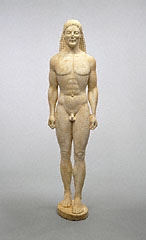
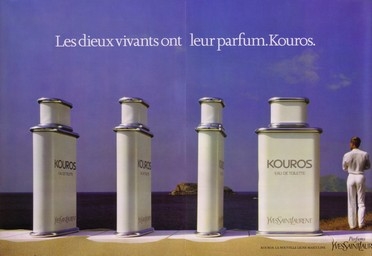

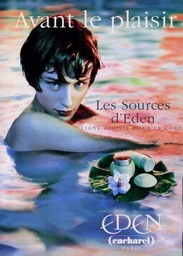 Named after the primeval garden of creation, Eden by parfums Cacharel broke new ground back when it launched in 1994 being the first fruity-semioriental-aquatic. Yes, I know, it sounds like an improbable combination, but it managed to smell enticing nevertheless. At least it did to me for the first bottle or so. Later I became bored with it and left it aside, never repurchasing. The body lotion was very nice and continued to remind me of the scent for a while longer.
Named after the primeval garden of creation, Eden by parfums Cacharel broke new ground back when it launched in 1994 being the first fruity-semioriental-aquatic. Yes, I know, it sounds like an improbable combination, but it managed to smell enticing nevertheless. At least it did to me for the first bottle or so. Later I became bored with it and left it aside, never repurchasing. The body lotion was very nice and continued to remind me of the scent for a while longer. 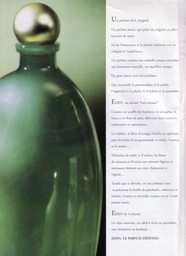
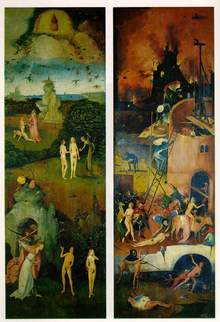
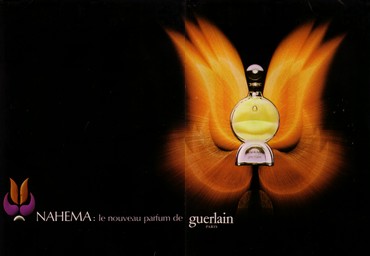 The sonorous name comes from the 1001 Nights, in a story by Scheherazade recounted on the one and only day of her storytelling. (Scheherazade is also the name of a
The sonorous name comes from the 1001 Nights, in a story by Scheherazade recounted on the one and only day of her storytelling. (Scheherazade is also the name of a 
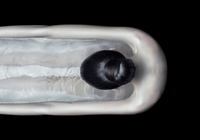
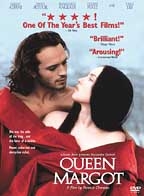
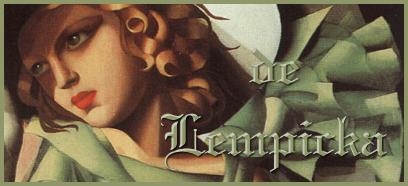 It’s really hard to imagine a summer scent, bottled in a turquoise blue bottle smelling of vanillic warmth and musky hugs. But here is proof to persuade us otherwise.
It’s really hard to imagine a summer scent, bottled in a turquoise blue bottle smelling of vanillic warmth and musky hugs. But here is proof to persuade us otherwise. 

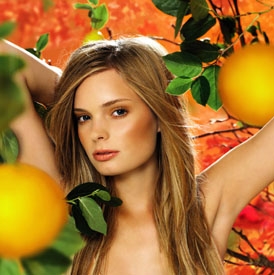 There seems to be a trend among companies for single scents focusing on a specific idea that could be combined with one another or worn individually: Marc Jacobs has done it with
There seems to be a trend among companies for single scents focusing on a specific idea that could be combined with one another or worn individually: Marc Jacobs has done it with 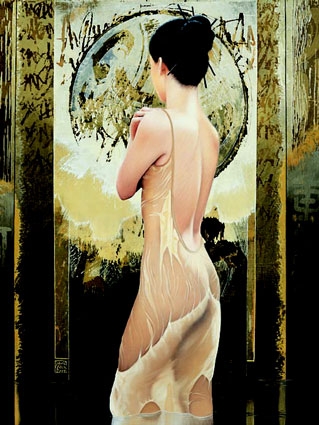 Tuberose(Polianthes tuberose): the flower of spiritual ruin, the carnal blossom, the heady mistress of the night (rat ki rani in India), a lily plant originally native to the Americas.
Tuberose(Polianthes tuberose): the flower of spiritual ruin, the carnal blossom, the heady mistress of the night (rat ki rani in India), a lily plant originally native to the Americas.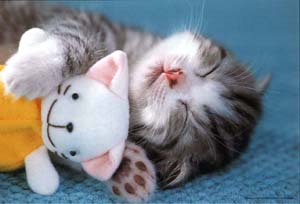 Essence of a dream, that is Extrait de songe, was the very poetic name of a limited edition “clean”perfume for summer 2005 by L’artisan Parfumeur. The latter lost a legal battle over the coveted name with Annick Goutal who had the name Songes (=dreams) copyrighted for her own, completely different, composition. Hence the lovely Extrait de Songe became extinct.
Essence of a dream, that is Extrait de songe, was the very poetic name of a limited edition “clean”perfume for summer 2005 by L’artisan Parfumeur. The latter lost a legal battle over the coveted name with Annick Goutal who had the name Songes (=dreams) copyrighted for her own, completely different, composition. Hence the lovely Extrait de Songe became extinct.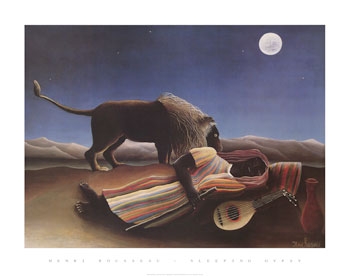 Is a terrible drought something you have dreamed of? Is its aridness something you have seen with your mental eye? “Perfumes are pictures, painted with scents” the creator of today’s scent says. “We work on the brightness, the tonality of the colours, the contrasts; we draw lines and figures and thus, create impressions that are unique and remain natural” . Part of the
Is a terrible drought something you have dreamed of? Is its aridness something you have seen with your mental eye? “Perfumes are pictures, painted with scents” the creator of today’s scent says. “We work on the brightness, the tonality of the colours, the contrasts; we draw lines and figures and thus, create impressions that are unique and remain natural” . Part of the 
 The inner intellectual abhors the manipulated image of beach babes that are flooding today’s media. Fake breasts, dyed highlighted hair, gleaming teeth, self-tanned skin, smiles up to the ears for no apparent reason, gams that go on for miles. Not all of that is bad, really, and I insist on that point vehemently (I could do with the gams fine myself) but perhaps when the total equals
The inner intellectual abhors the manipulated image of beach babes that are flooding today’s media. Fake breasts, dyed highlighted hair, gleaming teeth, self-tanned skin, smiles up to the ears for no apparent reason, gams that go on for miles. Not all of that is bad, really, and I insist on that point vehemently (I could do with the gams fine myself) but perhaps when the total equals  I have often wondered if
I have often wondered if 



